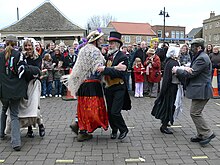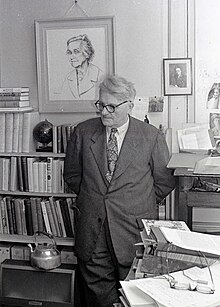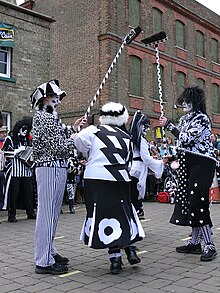
Molly dancing is a form of English Morris dance, traditionally done by out-of-work ploughboys in midwinter in the 19th century. It was largely ignored by folk dance collectors, who recorded only a handful of dances before the practice died out in the 1930s. The practice was revived in the 1970s.
History

Molly dancing is a dance tradition from East Anglia, first attested in the 1820s. The first recorded use of the word "Molly" in relation to this tradition was in 1866. The dance was performed on Boxing Day (26 December) and Plough Monday (the Monday after 6 January). The tradition had died out by 1940. The term "Molly dancing" probably derives from the word "Molly" meaning an effeminate, homosexual, or cross-dressing man, referring to the invariable presence of men dressed in women's clothing among the dancers; an alternative possibility is that it is a corruption of Morris dance.
In 1911 Cecil Sharp interviewed a man from Little Downham about Plough Monday dancing, but he did not consider it worthy of further study, and the practice was largely ignored by collectors of folk dances until the 1930s. In 1930, Joseph Needham and Arthur Peck collected four Molly dances from a dancer from Girton and a concertina player from Histon, near Cambridge; they continued to collect information about Molly dancing over the following three years. William Palmer recorded a broom dance performed by the Little Downham dancers in 1933. In 1978, Russell Wortley and Cyril Papworth published four dances collected from the Comberton Molly dancers.
Traditions
Traditionally Molly dancing took place over the Christmas season, particularly on Boxing Day and Plough Monday (the first Monday after Epiphany). Pre-revival molly dancing was an all-male tradition, though women sometimes joined in the dancing. Unemployed farmworkers danced both to entertain themselves and as a way of making some money in a season where there was little demand for agricultural labour. In some cases, the money raised was used for charity – as for instance in Brandon Creek, near Littleport, where until the 1850s it was used to buy food for local widows.
Molly dancers dressed in ordinary clothes decorated with ribbons and rosettes, wore top hats, and blacked their faces as a form of disguise. One or more dancers dressed in women's clothing – in some accounts half of the dancers were dressed as women. Along with the dancers, molly teams were accompanied by various other men who performed specific roles, including an umbrella man, to protect the musician from the weather, a sweeper who carried a broom and would clear a space for the dancers, and the man responsible for the money box. The Molly team seen by William Palmer at Little Downham in 1933 consisted of six men, one dressed as a woman; of the remaining five, one carried a broom and money box, and one played the accordion. The musician wore ordinary clothes, while the other men wore frock coats and top hats; all five had blackened faces and wore ribbons on their clothes.
Revival
| This section needs additional citations for verification. Please help improve this article by adding citations to reliable sources in this section. Unsourced material may be challenged and removed. (November 2024) (Learn how and when to remove this message) |

Molly dancing was revived in the late 1970s, when teams began to once again perform the preserved dances. By 1976, Russell Wortley was teaching Molly dance based on the material he had collected, and in 1977 the Cambridge Morris Men resumed Molly dancing on Plough Monday. The Cambridge Men still dance Molly during the day on Plough Monday. The Morris dance revival of the 1970s led to the creation of many new sides, which nowadays usually involve both men and women.
In recent years, Molly dancing has enjoyed a popular revival both in East Anglia and the East Midlands, one of the best-known teams being the Ouse Washes Molly Dancers. The largest regular assemblage of Molly dancers is at the Whittlesea Straw Bear Festival, established 1980, which is held in Whittlesey, Cambridgeshire, every January.
Modern Molly dancing demonstrates the clearest distinction between "re-enactment of tradition" and "modern interpretation of tradition" of modern morris dancing. Elaine Bradtke wrote a PhD thesis on the inherent post-modernism of the Seven Champions, one of the first and best examples of modern Molly dance. Many other teams have developed Molly, inspired by the unhistorical but very effective military formations of Seven Champions (e.g. Ouse Washes, Gog Magog, Handsome Molly in New Jersey, Countess Isabella's Automata) whilst others have taken it in new directions, equally unhistorical but at their best equally effective in very different ways; e.g. Norwich Shitwitches (now renamed Kit Witches) and Pig Dyke Molly.
References
- "Molly dancing". A Dictionary of English Folklore. Oxford University Press. 2003.
- ^ Bradtke 1999, p. 7.
- Bradtke 1999, pp. 18–21.
- Simons 2019, pp. 193–194.
- Needham & Peck 1933, pp. 80–83.
- Simons 2019, pp. 194–195.
- Palmer 1974, pp. 24–25.
- Wortley & Papworth 1978, p. 58.
- ^ Bradtke 1999, p. 17.
- ^ Bradtke 1999, p. 19.
- Bradtke 1999, p. 16.
- Bradtke 1999, pp. 7, 12–13, 18–19.
- Bradtke 1999, p. 18.
- Palmer 1974, p. 24.
- Frampton 2002, p. 10.
- Irvine 2018, p. 20.
Works cited
- Bradtke, Elaine (1999). Truculent Rustics: Molly Dancing in East Anglia Before 1940. London: FLS Books.
- Frampton, George (2002). "The Molly Dance Revival". Morris Matters. 21 (1).
- Irvine, Richard D. G. (2018). "Following the Bear: The revival of Plough Monday traditions and the performance of rural identity in the East Anglian fenlands". Ethnoscripts. 20 (1).
- Needham, Joseph; Peck, Arthur L. (1933). "Molly Dancing in East Anglia". Journal of the English Folk Dance and Song Society. 1 (2): 79–85. JSTOR 4521024.
- Palmer, William (1974). "Plough Monday 1933 at Little Downham". English Dance and Song. 36 (1).
- Simons, Matthew (2019). Morris Men: Dancing Englishness, c.1905-1951 (PDF) (PhD thesis). De Montfort University.
- Wortley, Russell; Papworth, Cyril (1978). "Molly Dancing in South West Cambridgeshire". English Dance and Song.